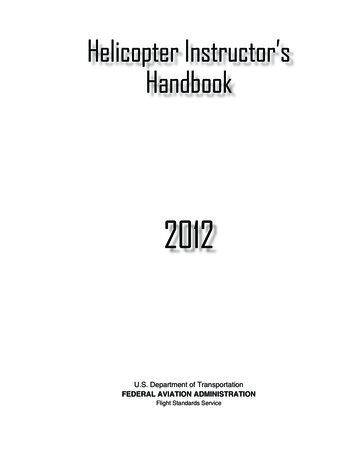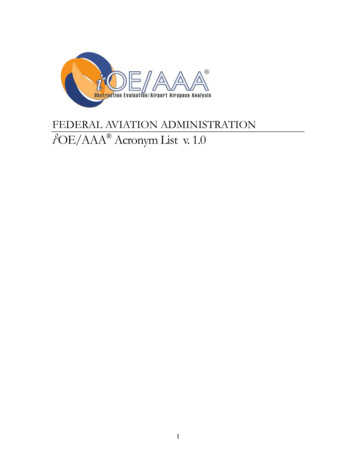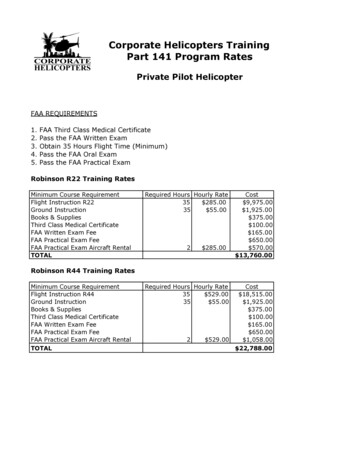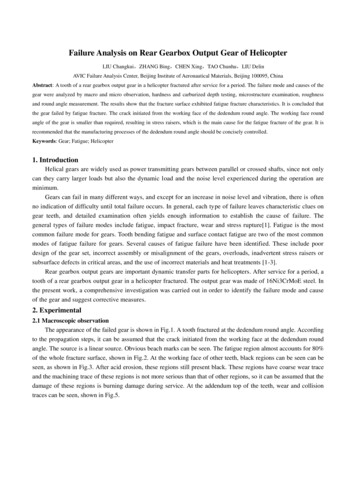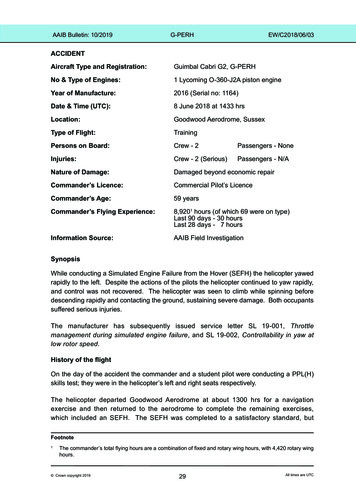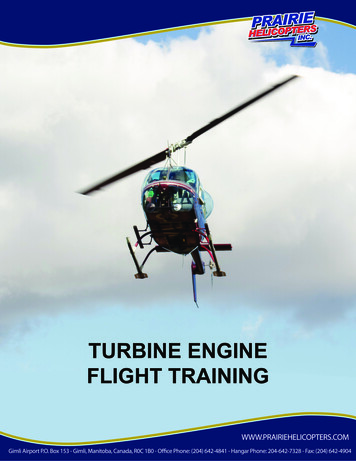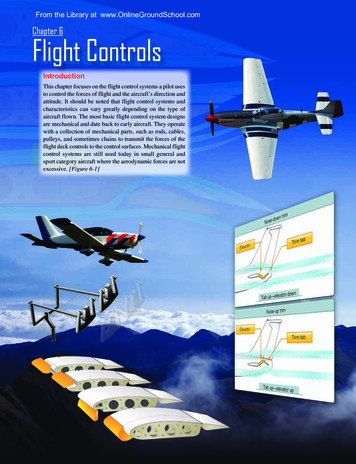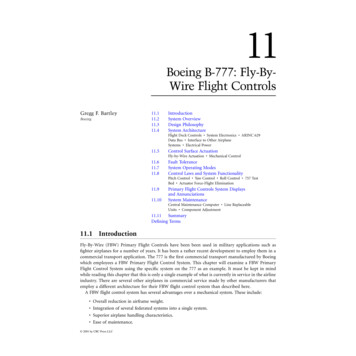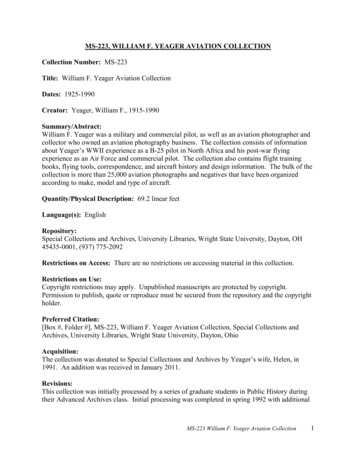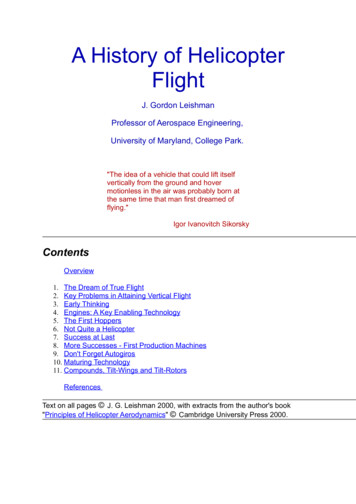
Transcription
A History of HelicopterFlightJ. Gordon LeishmanProfessor of Aerospace Engineering,University of Maryland, College Park."The idea of a vehicle that could lift itselfvertically from the ground and hovermotionless in the air was probably born atthe same time that man first dreamed offlying."Igor Ivanovitch SikorskyContentsOverview1. The Dream of True Flight2. Key Problems in Attaining Vertical Flight3. Early Thinking4. Engines: A Key Enabling Technology5. The First Hoppers6. Not Quite a Helicopter7. Success at Last8. More Successes - First Production Machines9. Don't Forget Autogiros10. Maturing Technology11. Compounds, Tilt-Wings and Tilt-RotorsReferencesText on all pages J. G. Leishman 2000, with extracts from the author's book"Principles of Helicopter Aerodynamics" Cambridge University Press 2000.
OverviewDuring the past sixty years since theirfirst successful flights, helicopters havematured from unstable, vibratingcontraptions that could barely lift thepilot off the ground, into sophisticatedmachines of extraordinary flyingcapability. They are able to hover, flyforward, backward and sideward, andperform other desirable maneuvers. Igor Sikorsky lived long enough to have thesatisfaction of seeing his vision of a flying machine "that could lift itself vertically fromthe ground and hover motionless in the air" come true in many more ways than hecould have initially imagined. At the beginning of the new Millennium, there were inexcess of 40,000 helicopters flying worldwide. Its civilian roles encompass airambulance, sea and mountain rescue, crop dusting, fire fighting, police surveillance,corporate services, and oil-rig servicing. Military roles of the helicopter are extensive,including troop transport, mine-sweeping, battlefield surveillance, assault and antitank missions. In various air-ground and air-sea rescue operations, the helicopter hassaved the lives of over a million people. Over the last forty years, sustained scientificresearch and development in many different aeronautical disciplines has allowed forlarge increases in helicopter performance, lifting capability of the main rotor, highspeed cruise efficiencies, and mechanical reliability. Continuous aerodynamicimprovements to the efficiency of the rotor have allowed the helicopter to lift morethan its empty weight and to fly in level flight at speeds in excess of 200 kts (370km/h; 229 mi/h). Since the 1980s, there has been an accelerating scientific effort tounderstand and overcome some of the most difficult technical problems associatedwith helicopter flight, particularly in regard to aerodynamic limitations imposed by themain rotor. The improved design of the helicopter and the increasing viability of othervertical lift aircraft such as the tilt-rotor continue to advance as a result of therevolution in computer-aided design and manufacturing and the advent of newlightweight composite materials. The helicopter today is a safe, versatile, and reliableaircraft, that plays a unique role in modern aviation provided by no other aircraft.Back to ContentsThe Dream of True FlightComparedto airplanes, the development of which can be clearly traced to OttoLilienthal, Samuel Langley, and the first fully controlled flight of a piloted poweredaircraft by Orville and Wilbur Wright in 1903, the origins of successful helicopter flightare considerably less clear. A pure helicopter can be defined as any flying machineusing rotating wings (i.e., a rotor with blades that spin about a shaft) to provide lift,propulsion, and control forces that enable the aircraft to hover relative to the groundwithout forward flight speed to generate these forces. In addition, to be practical, the
machine must also be able to fly forward, climb, cruise at speed, and then descendand come back into a hover for landing. This is the dream of true flight, a feat onlyachieved in nature by the hummingbird or dragonfly. Nature has inspired humankindfor literally hundreds of years before the vertical flight machine we now know as ahelicopter became a practical reality.The price of an aircraft that could safely and efficiently perform these very demandingflight maneuvers under full control of a pilot is significant mechanical andaerodynamic complexity. While one can draw several parallels in the technicaldevelopment of the helicopter when compared to fixed-wing aircraft, the longer andmore tumultuous gestation of vertical flight aircraft is a result of the greater depth ofknowledge required before all the various aerodynamic and mechanical problemscould be understood and overcome. Besides the need to understand the basicaerodynamics of vertical flight and improve upon the aerodynamic efficiency of thehelicopter, other technical barriers included the need to develop powerplants(engines) with high power-to-weight ratios, as well as high-strength, low-weightmaterials for the rotor and airframe. As these key technologies have matured duringthe last seventy years, the helicopter has grown from a vibrating rickety contraptionthat was barely able to lift its own weight into a modern and efficient aircraft ofconsiderable engineering sophistication.Back to ContentsKey Problems in Attaining Vertical FlightThereare several authoritative sources that document the development ofhelicopters and other rotating-wing aircraft such as autogiros. These authors includeGregory (1944), Lambermont (1958), Gablehouse (1967), Gunston (1983), Apostolo(1984), Boulet (1984), Lopez & Boyne (1984), Taylor (1984), Everett-Heath (1986),Fay (1987) and Spenser (1999), amongst others. Boulet (1984) has a uniqueperspective, giving a first-hand account of the early helicopter developments thoughinterviews with the pioneers, constructors, and pilots of the machines. A detailedhistory of very early, and perhaps even obscure, helicopter developments is given byLiberatore (1950, 1988, 1998). For original publications documenting the earliesttechnical developments of the autogiro and helicopter, see Warner (1920), vonKármán (1921), Balaban (1923), Moreno-Caracciolo (1923), Klemin (1925), Wimperis(1926) and Seiferth (1927).As described by Liberatore (1998), the early work on the development of thehelicopter can be placed into two categories: inventive and scientific. The former isone where intuition is used in lieu of formal technical training, whereas the latter isone where a trained, systematic approach is used. At the beginning of the twentiethcentury nearly all prior attempts at vertical flight can be considered as inventive, theinherent aerodynamic and mechanical complexities of building a vertical flight aircraftresisting many ambitious efforts. A contributing factor was the relatively few scientificinvestigations of flight or studies into the science of aerodynamics -- see Anderson(1997). The history of flight documents literally hundreds of failed helicopter
inventions, which either had inadequate installed power or limited control capability,or more often than not, the machine just vibrated itself to pieces. Some of the betterdesigned early machines made brief hops into the air, but control of the aircraft waslimited. Yet, the quest for true mastery of the air continued to inspire many inventorsand, in time, their work led to sustained technical efforts by trained engineers and,ultimately, to the successful development of the modern helicopter. The technicalcontributions of Juan de la Cierva, Louis Breguet, Heinrich Focke, Raoul Hafner, IgorSikorsky and Arthur Young stand out, and their work was instrumental in the designof truly safe and practical helicopters.Six fundamental technical problems can be identified that limited early experimentswith helicopters. These problems have been described by Igor Sikorsky (1938) andother sources. In summary, these problems were:1. Understanding the basic aerodynamics of vertical flight: The theoreticalpower required to produce a fixed amount of lift was an unknown quantity tothe earliest experimenters, who were guided more by intuition than by science.While basic theories describing the operation of thrusting rotors had beenestablished by the end of the nineteenth century by William Rankine (1855),W. Froude (1878) and R. E. Froude (1889), the first significant application ofaerodynamic theory to helicopter rotors came about in the early 1920s.2. The lack of a suitable powerplant (engine): This was a problem that wasnot to be overcome until the beginning of the twentieth century by thedevelopment of internal combustion (gasoline) powered engines. Yet, it wasnot until the mid-1920s that engines with sufficient power and with the highpower to weight ratios suitable for vertical flight became more widely available.3. Minimizing structural weight and engine weight: Early power plants weremade of cast iron and were relatively heavy. Aluminum, a common materialused on modern aircraft, was not available commercially until about 1890, buteven then was inordinately expensive. Aluminum was not widely used inaeronautical applications until 1920.4. Counteracting rotor torque reaction: The idea of a tail rotor to countertorque reaction and provide directional control was not used on most earlydesigns. Most early machines were built with either coaxial or laterally side-byside rotor configurations. Yet, building and controlling two rotors was evenmore difficult that for one rotor. Igor Sikorsky was the first to successfully usethe tail rotor in the single rotor helicopter configuration we know today.5. Providing stability and properly controlling the machine: A primaryconcern was to devise a means of defeating the unequal lift produced on theblades advancing into and retreating from the relative wind when in forwardflight. These were problems that were only to be fully overcome with the use ofblade articulation in the form of flapping and lead/lag hinges, ideas that werepioneered by Cierva, Breguet, and others, and with the development of bladecyclic pitch control.6. Conquering the problem of high vibrations: Vibration was a source ofmany mechanical failures of the rotor and airframe, and reflected aninsufficient understanding of the dynamic and aerodynamic behavior ofrotating-wings.
While all of the factors listed above contributed in some way to the lack of initialprogress in achieving successful vertical flight, the development of a practicalhelicopter had to wait until engine technology could be refined to the point thatlightweight engines with considerable power could be built. By 1920, gasolinepowered piston engines with higher power-to-weight ratios were more widelyavailable, and the control problems of achieving successful vertical flight were at theforefront. This era is marked by the development of a vast number of prototypehelicopters throughout the world. Most of these machines made short hops into theair or flying slowly in ground effect. Many of the early designs were built in GreatBritain, France, Germany, Italy, and the United States, who led the field in severaltechnical areas. However, with all the various incremental improvements that hadbeen made to the basic helicopter concept during the pre-World War 2 years, it wasnot until the late interwar period that significant technical advances were made, andmore practical helicopter designs that could lift both a pilot and a substantial payloadbegan to appear.Back to ContentsEarly ThinkingThe ideas of vertical flight aircraft can be traced back to early Chinese tops, a toyfirst used about 400 BC. Everett-Heath (1986) and Liberatore (1998) give a detailedhistory of such devices. The earliest versions of the Chinese top consisted of feathersat the end of a stick, which was rapidly spun between the hands to generate lift andthen released into free flight. These toys were probably inspired by observations ofthe seeds of trees such as the sycamore, whose whirling, autorotating seeds can beseen to carry on the breeze. More than 2,000 years later, about 1754, MikhailLomonosov of Russia had developed a small coaxial rotor modeled after the Chinesetop but powered by a wound-up spring device. The device flew freely and climbed toa good altitude.In 1783, the French naturalist Launoy, with the assistance ofBienvenu, his mechanic, used a coaxial version of the Chinesetop in a model consisting of a counterrotating set of turkeyfeathers. This relatively large device was powered by a stringwound around the rotor shaft and tensioned by a crossbow.When the tension was released, the blades whirled and thedevice climbed high into the air.Launoy & Bienvenu's inventioncreated quite a stir in scientificcircles. Inspired by the early success with these and othersuch whirling tops, the French mathematician A. J. P.Paucton published in 1786 one of the first scientificpapers on the problem of rotating wings entitled "Theoriede la vis D'Archimede."
Amongst his many elaborate drawings, the Renaissance visionary Leonardo da Vincishows what is a basic human-carrying helicopterlike machine. His sketch of the"aerial-screw" or "air gyroscope" device is dated to 1483 but it was first publishednearly three centuries later. (Da Vinci's original drawing is MS 2173 of Manuscript(codex) B, folio 83 verso, in the collection of the Biblotheque L'Institute de France,Paris.) Da Vinci's idea was an obvious elaboration of an Archimedes water-screw, butwith keen insight to the problem of flight. His proposed device comprised a helicalsurface formed out of iron wire, with linen surfaces made "airtight with starch." DaVinci describes that the machine should be "rotated with speed that said screw boresthrough the air and climbs high." He obviously realized that the density of air wasmuch less than that of water, so da Vinci describes how the device needed to berelatively large to accomplish this feat -- the number "8" in his backward mirror imagescript and to the left of the sketch indicates that the size of the rotor is eight braccia.(A braccia is an old Florentine unit of measure approximately equal to one arm'slength, which translates into a rotor of roughly 20-feet in diameter.) Da Vinci clearlydid not build his machine, except perhaps for some small models, but his idea wasclearly far ahead of its time. See Hart (1961) or Giacomelli (1930) for further readingon da Vinci's aeronautical inventions. Although da Vinci worked on various conceptsof engines, turbines, and gears, his sketches did not seem to unite the ideas of hisaerial-screw machine to an engine. Nor did da Vinci seem to appreciate the conceptof torque-reaction -- a well-known problem to all rotary-wing engineers where atorque applied to the rotor shaft will result in a reaction torque tending to rotate theplatform from which the torque is applied.Sir George Cayley is famous for his work on thebasic principles of flight, which dates from the 1790s-- see Pritchard (1961). As a young boy, Cayley hadbeen fascinated by the Chinese top, and by the endof the eighteenth century had constructed severalsuccessful vertical-flight models with rotors made ofsheets of tin and driven by wound-up clock springs.As a young man, his fascination with flight led him todesign and construct a whirling-arm device in 1804,which was probably one of the first scientific attempts to study the aerodynamicforces produced by lifting wings. Cayley (1809-10) published a three-part paper thatwas to lay down the foundations of modern aerodynamics -- see Anderson (1997). Ina later paper, published in 1843, Cayley gives details of a relatively large verticalflight aircraft design that he called an "Aerial Carriage." The machine had two pairs oflateral side-by-side rotors to provide lift, and were pushed forward by propellers. Hisidea seemed to be that the disks flattened down in forward flight, becoming circularwings. However, Cayley's device only remained an idea because the onlypowerplants available at the time were steam engines, and these were much tooheavy to allow for successful powered flight.The lack of a suitable powerplant continued to stifle aeronautical progress, both forfixed and rotating wing applications, but the use of miniature lightweight steamengines met with some success. In the 1840s, another Englishman, Horatio Phillips,constructed a steam-driven vertical flight machine where steam generated by aminiature boiler was ejected out of the blade tips. Although impractical to build at fullscale, Phillips's machine was significant in that it marked the first time that a model
helicopter had flown under the power of an engine rather than stored energy devicessuch as wound-up springs.In the early 1860s, Ponton d'Amecourt of France flew anumber of small steam-powered helicopter models. Hecalled his machines helicopteres, which is a word derivedfrom the Greek adjective "elikoeioas" meaning spiral orwinding, and the noun "pteron" meaning feather or wing -see Wolf (1974) and Liberatore (1998). However, thenovelist Jules Verne was still impressed with d'Amecourt'sattempts, and in 1886 he wrote "The Clipper of theClouds" where the hero of the novel cruised around theskies in a giant helicopterlike machine that was lifted bythirty-seven small coaxial rotors and pulled through the airby two propellers.Other notable vertical flight models that wereconstructed at about this time include thecoaxial design of Bright in 1861 and the twinrotor steam-driven model of Dieuaide in 1877.Wilheim von Achenbach of Germany built asingle rotor model in 1874, and he was probablythe first to use the idea of a sideward thrustingtail rotor to counteract the torque reaction from the main rotor. Later, Achenbachconducted experiments with propellers, the results of which were published by NACA-- see Achenbach (1923). About 1869 a Russian helicopter concept was developedby Lodygin, using a rotor for lift and a propeller for propulsion and control. Around1878, Enrico Forlanini of Italy also built another type of flying steam-driven helicoptermodel. This model had dual counterrotating rotors, and it is recorded that it flew freelyat heights of over forty feet for as much as twenty seconds.In the 1880s, the well-known scientist and inventor Thomas Alva Edisonexperimented with small helicopter models in the United States. He tested severalrotor configurations driven by a gun cotton engine, which was an early form ofinternal combustion engine. A series of explosions deterred further efforts with theseengines. Later, Edison used an electric motor for power, and he was one of the firstto realize from his experiments the need for a large diameter rotor with low bladearea to give good hovering efficiency. Unlike other inventors and experimenters of thetimes, Edison's more scientific approach to the vertical flight problem proved thatboth high aerodynamic efficiency of the rotor and high power from an engine wererequired if successful flight was to be achieved. In 1910, Edison patented a rathercumbersome looking full-scale helicopter concept with boxkite-like blades, but thereis no record that it was ever constructed. Edison, however, was to remain a staunchsupporter of helicopter concepts for the rest of his life.Back to Contents
Engines: A Key Enabling TechnologyThe development of the engine (powerplant) is fundamental to any form of flight.While airplanes could fly with engines of relatively lower power, the success of thehelicopter had to wait until aircraft engine technology could be refined to the pointthat much more powerful and lightweight engines could be built. A look at thehistorical record shows that the need for engines of sufficient power-to-weight ratiowas really a key enabling technology for the success of the helicopter.To the early pioneers, the power required for successful vertical flight was anunknown quantity and an understanding of the problem proceeded mostly on a trialand error basis. The early rotor systems had extremely poor aerodynamicperformance, with efficiencies (figures of merit) of no more than 50%. This isreflected in the engines used in some of the helicopter concepts designed in the early1900s, which were significantly overpowered and overweight. Prior to 1870, thesteam engine was the only powerplant available for use in most mechanical devices.The steam engine is an external combustion engine and, relatively speaking, it isquite a primitive form of powerplant. It requires a separate boiler, combustor,recirculating pump, condenser, power producing piston and cylinder and well as afuel and an ample supply of water. All of these components would make it verydifficult to raise the power to weight/ratio of a steam engine to a level suitable foraeronautical use. Nonetheless, until the internal combustion engine was developed,the performance of steam engines was to be steadily improved upon, being broughtto a high level of practicality by the innovations of James Watt.The state-of-the-art of aeronautical steam engine technology in the mid-nineteenthcentury is reflected in the works of British engineers Stringfellow and Hensen andalso the American, Charles Manly. The Hensen steam engine weighed about 16lb(7.26kg) andproduced about 1hp (0.746kW), giving a power-to-weight ratio of about0.06, which as about three times that of a traditional steam plant of the era. Fueledby methyl alcohol, this was also a more practical fuel for use in aeronauticalapplications. However, to save weight the engine lacked a condenser and so ran ona fixed supply of water. With a representative steam consumption of30lb/hp/hr(18.25kg/kW/hr) this was too high for aircraft use. A steam engine of this type wasalso used by Erico Forlanini of Italy in about 1878 for his experiments with coaxialhelicopter rotor models.In the United States, Charles Manly built a relatively sophisticated five cylinder steamengine for use on Langley's Aerodrome. The cylinders were arranged radially aroundthe crankcase, a form of construction that was later to become a basis for the popularair-cooled radial reciprocating internal combustion aircraft engine. Manly's engineproduced about 52hp (36.76kW) and weighed about 151lb (68.5kg), giving a powerto-weight ratio of 0.34hp/lb (0.56kW/kg). The Australian, Lawrence Hargreve, workedon many different engine concepts, including those powered by steam and gasoline.Hargreve was probably the first to devise the concept of a rotary engine, where thecylinders rotated about a fixed crankshaft, another popular design that was later to beused on many different types of aircraft including helicoptersThe internal-combustion engine came about in the mid-20th century and was a resultof the scientific contributions from many individuals. Realizing the limitations of the
steam engine, there was gradual accumulation of knowledge in thermodynamics,mechanics, materials and liquid fuels science. One of the earliest studies of thethermodynamic principles was by Sadi Carnot in 1824 in his famous paper"Reflections on the Motive Power of Heat." In 1862, Alphose Beau de Rochaspublished the first theory describing the 4-stroke cycle. In 1876, Nikolaus Otto was touse Rochas's theory to design an engine that was to form the basis for the moderngasoline powered reciprocating engine. The development of the internal combustionengine eliminated many parts, simplified the overall powerplant system and for thefirst time enabled the construction of a compact powerplant of high power/weightratio.The earliest gasoline powered aircraft engines were of the air-cooled rotary type. Thepopular French "Gnome" and "Le Rhone" rotary engines had power-to-weight ratiosof 0.35hp/lb (0.576kW/kg) and were probably the most advanced lightweight enginesof their time. This type engine was used by many helicopter pioneers of the era,including Igor Sikorsk in his test rig of 1910. The rotary engine suffered from inherentdisadvantages, but compared to other types of engines that were available at thetime, they were smooth running and sufficiently lightweight to be suitable for aircraftuse. The technology to enable vertical flight was now finally at hand.Back to ContentsThe First HoppersIn 1907, about four years after the Wright brothers' first successful powered flights infixed-wing airplanes atKitty Hawk in theUnitedStates,aFrench bicycle makenamed Paul Cornuconstructed a verticalflight machine that wasreportedtohavecarried a human off theground for the first time. Boulet (1984) gives a good account of the work. Theairframe was very simple, with a rotor at each end. Power was supplied to the rotorsby a gasoline motor and belt transmission. Each rotor had two relatively large but lowaspect ratio blades set at the periphery of a large spoked wheel. The rotors rotated inopposite directions tocancel torque reaction. Aprimitive means of controlwas achieved by placingauxiliary wings in theslipstreambelowtherotors. The machine wasreported to have madeseveral tethered flights of
a few seconds at low altitude, but this has never been satisfactorily verified. Certainly,the 24-hp engine used in the machine was hardly powerful enough to have sustainedhovering flight out of ground effect.In 1904 French scientist and academician Charles Richet built a small, unpilotedhelicopter. While the machine was unsuccessful, one of Richet's students was thefuture famous aviation pioneer, Louis Breguet. During the latter part of 1906, thebrothers Louis and Jacques Breguet had begun to conduct helicopter experiments oftheir own under the guidance of Professor Richet. The Breguet Brothers were of anaffluent famous clock making family, and were subsequently to become pioneers inFrench aviation. Louis Breguet made meticulous tests of airfoil shapes, parallelingthose of the Wright Brothers [see Anderson (1997)], and without a doubt understoodthe essential aerodynamic theory of the helicopter. In 1907, the Breguet Brothersbuilt their first helicopter. Their ungainly quad-rotor Gyroplane No. 1 consisted of fourlong girders made of steel tubes and arranged in the form of a horizontal cross. Arotor consisting of four biplane blades was placed at each of the four corners of thecross, giving a total of 32 separate lifting surfaces. The pilot sat in the center of thecross next to a 40-hp engine. The machine is reported to have carried a pilot off theground, albeit briefly. Photographs show the assistance of several men stabilizingand perhaps even lifting the machine. Clearly, the machine never flew completelyfreely because, like the Cornu machine, it lacked stability and a proper means ofcontrol. However, the Breguet machine was more sophisticated and probably closerto achieving proper vertical flight than the machine built about the same time by PaulCornu.In the early 1900s, Igor Ivanovitch Sikorsky and Boris Yur'ev independently began todesign and build vertical-lift machines in Czarist Russia. By 1909, inspired by thework of Cornu and other French aviators, Sikorsky had built a nonpiloted coaxialhelicopter prototype. This machine did not fly because ofvibration problems and the lack of a powerful enoughengine. Sikorsky (1938) stated that he had to await "betterengines, lighter materials, and experienced mechanics."His first design, the S-1, was unable to lift its own weight,and the second machine, the S-2, only made short(nonpiloted) hops even with a more powerful engine.Discouraged, Sikorsky abandoned the helicopter idea anddevoted his skills to fixed-wing (conventional airplane)designs at which he was very successful. Although henever gave up his vision of the helicopter, it was not until the 1930s after he hademigrated to the United States that he again pursued his ideas of vertical flight. Goodaccounts of the life and work ofIgor Sikorsky are documentedby Bartlett (1947), Delear(1969), Sikorsky (1964, 1971),Sikorsky & Andrews (1984),Finne (1987), and Cochrane etal. (1989).
Unbeknown to Igor Sikorsky, Boris Yur'ev had also tried to build a helicopter inRussia around 1912. This machine had a very modern looking single rotor and tailrotor configuration. The large diameter, high aspect ratio blades suggested someknowledge that this was the configuration for high aerodynamic efficiency. Yet, likeSikorsky's S-1 and S-2, Yur'ev's aircraft lacked a powerful enough engine. Goodaccounts of Yur'ev's machine are given by Gablehouse (1967) and Liberatore (1998).The machine never flew properly, being plagued with mechnical failures. Yet, besidesbeing one of the first to use a tail rotor design, Yur'ev was another one of severalfirsts to propose the concepts of cyclic pitch for rotor control. In this vein, anotherearly cyclic pitch design was patented by Gaetano A. Crocco of Italy in 1906. Crocco,who pioneered the ideas of hydrofoil boats, recognized that if a helicopter was towork properly when in forward flight, a means of changing the pitch on the bladeswould be needed to account for the dissymmetry in the aerodynamic loads betweenthe side of the rotor advancing into the relative wind and the side retreating awayfrom the wind. As mentioned earlier, the concept of cyclic pitch was one key toattaining full control of the helicopter.There is also evidence of the construction of a primitive coaxial helicopter byProfessor Zhukovskii (Joukowski) and his students at Moscow University in 1910 -see Gablehouse (1967). Joukowski is well known for his theoretical contributions toaerodynamics, and besides other contributions to the field he published severalpapers on the subject of rotating wings and helicopters -- see Margoulis (1922) andTokaty (1971). While prior to 1900 Rankine and Froude had already established thegeneral theory of propellers and rotors using momentum theory, there were a numberof rapid developments in the basic aerodynamic theory. For example, the FrenchmanDrzewiecky had developed a hybrid momentum/blade element concept about 1900.In 1909 Drzewiecky published a book entitled "Des Helices Aeriennes TheorieGenerale des Propulseurs." In 1904, Joukowski published a paper entitled "On theUseful Load Lifted by a Helico
helicopter can be placed into two categories: inventive and scientific. The former is one where intuition is used in lieu of formal technical training, whereas the latter is one where a trained, systematic approach is used. At the beginning of the twentieth century nearly all prior attemp
